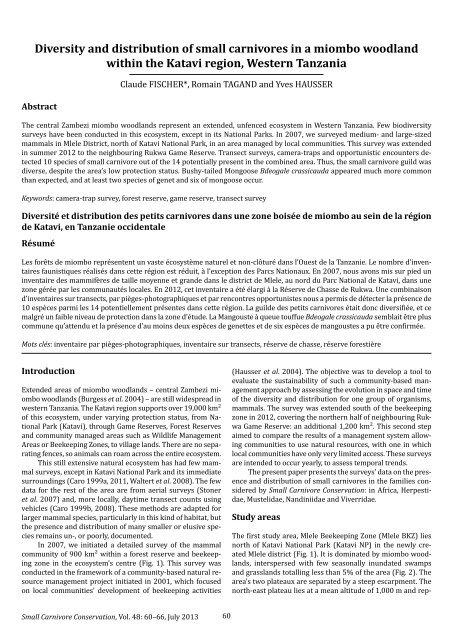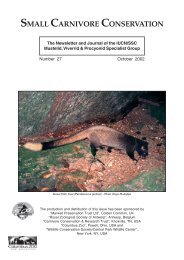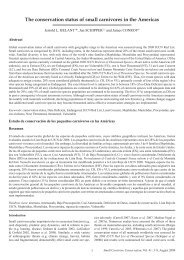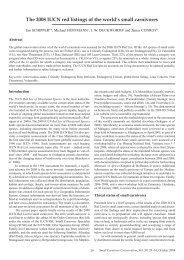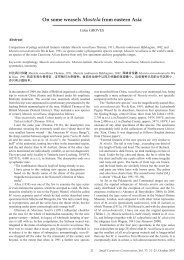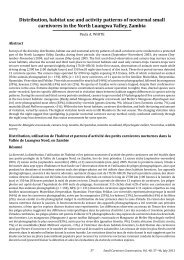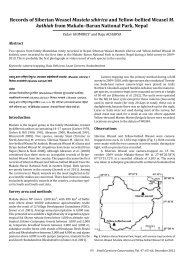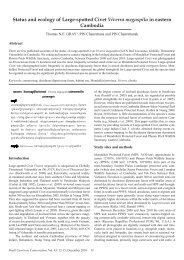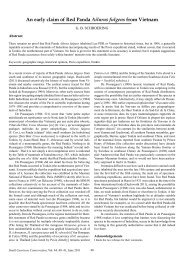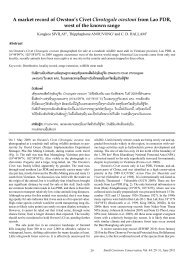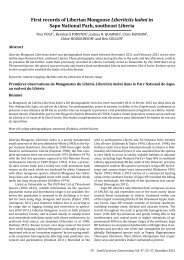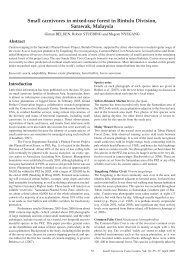Diversity and distribution of small carnivores in a miombo woodland ...
Diversity and distribution of small carnivores in a miombo woodland ...
Diversity and distribution of small carnivores in a miombo woodland ...
You also want an ePaper? Increase the reach of your titles
YUMPU automatically turns print PDFs into web optimized ePapers that Google loves.
Small <strong>carnivores</strong> <strong>in</strong> W TanzaniaTable 1. Small carnivore species potentially present <strong>in</strong> Mlele Beekeep<strong>in</strong>g Zone <strong>and</strong> the northern part <strong>of</strong> Rukwa Game Reserve,Tanzania (after TAWIRI 2009), detail<strong>in</strong>g those observed dur<strong>in</strong>g 2007–2012 surveys.Species 1 Scientific name SpeciesdetectedNumber <strong>of</strong> sites 2Mlele BKZ / RukwaGR-nMethod 3Activity patternobservedMiombo Genet Genetta angolensis YES 3/4 C, Tn NightRusty-spotted Genet Genetta maculata YES 1/- C NightCommon Genet Genetta genetta NO 0 - -Common Dwarf Mongoose Helogale parvula YES 17/- T, O DayB<strong>and</strong>ed Mongoose Mungos mungo YES 6/- C Day & nightCommon Slender Mongoose Herpestes sangu<strong>in</strong>eus YES 1/- T, O DayEgyptian Mongoose Herpestes ichneumon NO 0 - -White-tailed Mongoose Ichneumia albicauda YES 4/1 C, T, O Day & nightMarsh Mongoose Atilax palud<strong>in</strong>osus YES 7/1 C NightBushy-tailed Mongoose Bdeogale crassicauda YES 6/2 C NightHoney Badger Mellivora capensis YES 5/5 C, O Day & nightZorilla Ictonyx striatus NO 0 - -African Civet Civettictis civetta YES 3/5 C, O NightAfrican Palm Civet N<strong>and</strong><strong>in</strong>ia b<strong>in</strong>otata Probable [1]/- Tn Night1Otters are not considered as potentially present because there are no permanent water bodies <strong>in</strong> our study areas.2The number <strong>of</strong> sites represents the number <strong>of</strong> camera-trap locations <strong>and</strong> the number <strong>of</strong> direct sight<strong>in</strong>gs separated by at least 100 m.3C = camera-trap, T = day-time transect, Tn = night-time transect, O = opportunistic encounter.camera-trapped, by both day <strong>and</strong> night. Honey Badger Mellivoracapensis <strong>and</strong> African Civet Civettictis civetta were mostly cameratrapped,but there were some direct encounters: at night for AfricanCivet, <strong>and</strong>, once, by day for Honey Badger.Detection locations <strong>of</strong> each species (Fig. 4) give some broad<strong>in</strong>formation about their <strong>distribution</strong>, but need cautious <strong>in</strong>terpretation:only two months were spent <strong>in</strong> Rukwa GR-n versus n<strong>in</strong>e <strong>in</strong>Mlele BKZ. This big difference <strong>in</strong> sampl<strong>in</strong>g effort resulted <strong>in</strong> moreobservations <strong>in</strong> Mlele BKZ, except for African Civet (Table 1).DiscussionCamera-trap models <strong>and</strong> survey techniques not speciallyadapted for <strong>small</strong> <strong>carnivores</strong> found a fairly complete <strong>small</strong> carnivoreguild: 10 species from a predicted 14 species present<strong>in</strong> the area. Other species may be present: a probable AfricanPalm Civet − a species <strong>of</strong> uncerta<strong>in</strong> <strong>distribution</strong> <strong>in</strong> western Tanzania(Stuart & Stuart 2006, Wilson & Mittermeier 2009) − wasseen <strong>in</strong> 2007, <strong>and</strong> several genets were not identified to species.Additional species would plausibly be recorded by camera-trapp<strong>in</strong>gmore focused on <strong>small</strong> <strong>carnivores</strong>, which would:mount them lower to the ground (20–40 cm; Sarmento et al.2010, 2011, Ancrenaz et al. 2012); place some beside roads,trails, latr<strong>in</strong>es <strong>and</strong> termite hives; use lures; <strong>and</strong> use more sensitivedetectors. For <strong>in</strong>stance, we never camera-trapped CommonDwarf Mongoose, despite several direct observations. The speciesmay be too <strong>small</strong> <strong>and</strong> not mobile enough to be readily detectedby our camera-trap system; <strong>and</strong> 2-km grid-cells exceedits usually <strong>small</strong> home range (
Fischer et al.Fig. 4. Location maps <strong>of</strong> <strong>small</strong> <strong>carnivores</strong> <strong>in</strong> Mlele Beekeep<strong>in</strong>g Zone <strong>and</strong> the northern part <strong>of</strong> Rukwa Game Reserve,Tanzania; (above) mongooses (Herpestidae); <strong>and</strong> (below) genets Genetta.Small Carnivore Conservation, Vol. 48, July 201364
Small <strong>carnivores</strong> <strong>in</strong> W TanzaniaFig. 4 (cont<strong>in</strong>ued). Location maps <strong>of</strong> <strong>small</strong> <strong>carnivores</strong> <strong>in</strong> Mlele Beekeep<strong>in</strong>g Zone <strong>and</strong> the northern part <strong>of</strong> Rukwa GameReserve, Tanzania; (above) African Civet Civettictis civetta; (below )Honey Badger Mellivora capensis.65 Small Carnivore Conservation, Vol. 48, July 2013
Fischer et al.Fig. 5. Poach<strong>in</strong>g evidence <strong>in</strong> Mlele Beekeep<strong>in</strong>g Zone, Tanzania: left, a trap set up for Wild Cats Felis sylvestris<strong>and</strong> genets Genetta; right, a Miombo Genet Genetta angolensis killed with a spear by a poacher.AcknowledgementsWe are most grateful to the Village Game Scouts <strong>of</strong> Inyonga <strong>and</strong> to ourstudents for their precious help <strong>in</strong> the field. Many thanks to TAWIRI(Tanzanian Wildlife Research Institute) <strong>and</strong> COSTECH (Tanzania’sCommission for Technology) for grant<strong>in</strong>g permits to conduct our research,as well as the Wildlife Division <strong>of</strong> the M<strong>in</strong>istry <strong>of</strong> Natural Resources<strong>and</strong> Tourism. Many thanks also to Joseph Mwangombe, ProjectManager <strong>of</strong> Rukwa, Lukwati <strong>and</strong> Lwafi Game Reserves for his precioussupport. Many thanks to S<strong>and</strong>ra Haesler, S<strong>and</strong>y Mermod <strong>and</strong> JoanneFélix for their great help <strong>in</strong> the production <strong>of</strong> the maps. F<strong>in</strong>ally, wewould like to thank Charles Foley <strong>and</strong> Emmanuel Do L<strong>in</strong>h San for theirprecious help with species identifications, as well as two anonymousreferees for their useful comments on a first draft <strong>of</strong> our manuscript.ReferencesAncrenaz, M., Hearn, A. J., Ross, J., Sollmann, R. & Wilt<strong>in</strong>g, A. 2012.H<strong>and</strong>book for wildlife monitor<strong>in</strong>g us<strong>in</strong>g camera-traps. NaturalResources Office, Chief M<strong>in</strong>ister’s Department, Kota K<strong>in</strong>abalu,Sabah, Malaysia.Burgess, N. D., D’Amico Hales, J., Underwood, E., D<strong>in</strong>erste<strong>in</strong>, E., Olson,D., Itoua, I., Schipper, J., Ricketts, T. & Newman, K. 2004. Terrestrialecoregions <strong>of</strong> Africa <strong>and</strong> Madagascar: a cont<strong>in</strong>ental assessment.Isl<strong>and</strong> Press, Wash<strong>in</strong>gton D.C., U.S.A.Caro, T. M. 1999a. Abundance <strong>and</strong> <strong>distribution</strong> <strong>of</strong> mammals <strong>in</strong> KataviNational Park, Tanzania. African Journal <strong>of</strong> Ecology 37: 305−313.Caro, T. M. 1999b. Densities <strong>of</strong> mammals <strong>in</strong> partially protected areas:the Katavi ecosystem <strong>of</strong> western Tanzania. Journal <strong>of</strong> AppliedEcology 36: 205−217.Caro, T. M. 2008. Decl<strong>in</strong>e <strong>of</strong> large mammals <strong>in</strong> the Katavi−Rukwa ecosystem<strong>of</strong> western Tanzania. African Zoology 43: 99−116.Caro, T. M. 2011. On the merits <strong>and</strong> feasibility <strong>of</strong> wildlife monitor<strong>in</strong>gfor conservation: a case study from Katavi National Park, Tanzania.African Journal <strong>of</strong> Ecology 49: 320−331.De Luca, D. W. & Mpunga, N. E. 2005. Small <strong>carnivores</strong> <strong>of</strong> the UdzungwaMounta<strong>in</strong>s: presence, <strong>distribution</strong>s <strong>and</strong> threats. Small CarnivoreConservation 32: 1−7.Gilchrist, J. S., Jenn<strong>in</strong>gs, A. P., Veron, G. & Cavall<strong>in</strong>i, P. 2009. FamilyHerpestidae (Mongooses). Pp. 262−329 <strong>in</strong> Wilson, D. E. & Mittermeier,R. A. (eds) H<strong>and</strong>book <strong>of</strong> the mammals <strong>of</strong> the world, 1.Carnivores. Lynx Edicions, Barcelona, Spa<strong>in</strong>.Hausser, Y. & Mpuya, P. 2004. When the bees get out <strong>of</strong> the woods: an<strong>in</strong>novative cross-sectoral approach to community based naturalresource management. Game <strong>and</strong> Wildlife Science 21: 291−312.Hausser, Y., Tag<strong>and</strong>, R., Vimercati, E. & Fischer, C. <strong>in</strong> prep. Prelim<strong>in</strong>aryresults <strong>of</strong> a wildlife survey conducted <strong>in</strong> a multiple use protectedarea <strong>in</strong> Western Tanzania.K<strong>in</strong>gdon, J. 1997. The K<strong>in</strong>gdon field guide to African mammals. A. & C.Black, London, U.K.Pettorelli, N., Lobora, A. L., Msuha, M. J., Foley, C. & Durant, S. M. 2010.Carnivore diversity <strong>in</strong> Tanzania: reveal<strong>in</strong>g <strong>distribution</strong> patterns<strong>of</strong> secretive mammals us<strong>in</strong>g camera traps. Animal Conservation13: 131−139.Sarmento, P. B., Cruz, J. P., Eira, C. I. & Fonseca, C. 2010. Habitat selection<strong>and</strong> abundance <strong>of</strong> Common Genets Genetta genetta us<strong>in</strong>gcamera capture–mark–recapture data. European Journal <strong>of</strong> WildlifeResearch 56: 59−66.Sarmento, P. B., Cruz, J., Eira, C. & Fonseca, C. 2011. Model<strong>in</strong>g the occupancy<strong>of</strong> sympatric carnivorans <strong>in</strong> a Mediterranean ecosystem.European Journal <strong>of</strong> Wildlife Research 57: 119−131.Stoner, C., Caro, T. M., Mduma, S., Ml<strong>in</strong>gwa, C., Sabuni, G. & Borner, M.2007. Assessment <strong>of</strong> effectiveness <strong>of</strong> protection strategies <strong>in</strong> Tanzaniabased on a decade <strong>of</strong> survey data for large herbivores. ConservationBiology 21: 635−646.Stuart, C. & Stuart, T. 2006. Field guide to the larger mammals <strong>of</strong> Africa.Struik, Cape Town, South Africa.[TAWIRI] Tanzanian Wildlife Research Institute 2009. The Tanzania<strong>small</strong> carnivore conservation action plan. Pp. 162–269 <strong>in</strong> TAWI-RI (ed.) Tanzania carnivore conservation action plan. TAWIRI,Arusha, Tanzania.Waltert, M., Meyer, B., Shanyangi, M. W., Balozi, J. J., Kitwara, O., Quoli,S., Krischke, H. & Mühlenberg, M. 2008. Foot surveys <strong>of</strong> largemammals <strong>in</strong> woodl<strong>and</strong>s <strong>of</strong> Western Tanzania. Journal <strong>of</strong> WildlifeManagement 72: 603−610.Wilson, D. E. & Mittermeier, R. A. (eds) 2009. H<strong>and</strong>book <strong>of</strong> the mammals<strong>of</strong> the world, 1. Carnivores. Lynx Edicions, Barcelona, Spa<strong>in</strong>.University <strong>of</strong> Applied Sciences <strong>of</strong>Western Switzerl<strong>and</strong>, Department <strong>of</strong> NatureManagement, Geneva, Switzerl<strong>and</strong>.*Email: claude.fischer@hesge.chSmall Carnivore Conservation, Vol. 48, July 201366


